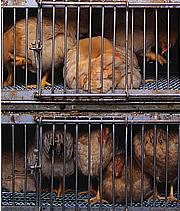 Making a vaccine without the help of chicken eggs could give us easier protection against bird flu.© Punchstock
Making a vaccine without the help of chicken eggs could give us easier protection against bird flu.© PunchstockResearchers in the United States have unveiled a new, faster way to produce vaccines against a strain bird-flu virus. They claim that the technique can create a vaccine against a specific strain within 36 days. This could permit a speedy response should the virus acquire the ability to spread easily from human to human.
The team, led by Andrea Gambotto of the University of Pittsburgh, Pennsylvania, has tested its method by creating a vaccine against H5N1; this strain caused the lethal outbreak in Vietnam during 2003-2005 that killed 42 people. The vaccine provides 100% protection in mice and chickens, the team reports in a paper published by the Journal of Virology1.
Gambotto now wants to proceed with human tests for the vaccine, which would be given as a nasal spray. He has asked for $2 million from the US government to fund a trial that would involve 72 patients and produce results within a year, he told news@nature.com.
Scale it up
Gambotto's team created the vaccine by recreating part of a genetic sequence that encodes a protein called haemagglutinin in the virus. They then spliced this into a modified form of the common cold virus, known as an adenovirus. The resulting package should stimulate the immune system to recognize and attack the haemagglutinin sequence in H5N1.
And this vaccine can be grown in bacteria in a culture dish, Gambotto points out. Almost all existing influenza vaccines are cultured in chicken eggs, and public-health experts have calculated that, at best, the world's capacity for egg-based production could yield about 250 million doses in a year, he says. This is far fewer than the billion or more doses that would be needed, says Gambotto.
Human tests of other H5N1 vaccines have been successful, but researchers have only seen protection from a double dose, and this would exacerbate the shortfall in production capacity (see 'Bird flu vaccine not up to scratch').
Gambotto argues that many labs around the world have the capacity to create a culture-based vaccine - possibly enough to meet the demands of a pandemic. "They should give us the chance to test it," he says.
Not enough?
David Fedson, former medical director at drug company Aventis Pasteur in Lyons, France, is less optimistic. Even using cell cultures rather than eggs, there may not be enough vaccine-production capacity to halt a pandemic in its tracks, he maintains.
Fedson predicts that it may be as much as five years before a vaccine can be produced in sufficient amount by any method.
ADVERTISEMENT
He also worries that many people in the population are already immune to the adenovirus strain used in Gambotto's vaccine. In North America, for instance, an estimated 30% of people already have antibodies against the strain; this means they could successfully fight the vaccine before they get a chance to develop antibodies to the H5N1 protein. This would make the vaccine ineffective.
Gambotto hopes that delivering the vaccine nasally rather than as a jab could get around this. "Studies have shown that there is no pre-existing immunity in the upper airways, even if there is in the blood," he says.
Gambotto adds that his animal study suggests that the vaccine stimulates a part of the human immune system, called T cells, that previous flu vaccines do not. T cells are flexible, he says, meaning that the vaccine could still work even if the virus were to mutate. "T-cell immunity is more potent," he says. "Only a really smart virus can overcome it."
Post a comment to this story by visiting our vaccinegetsoffthe_sta.html">newsblog.
